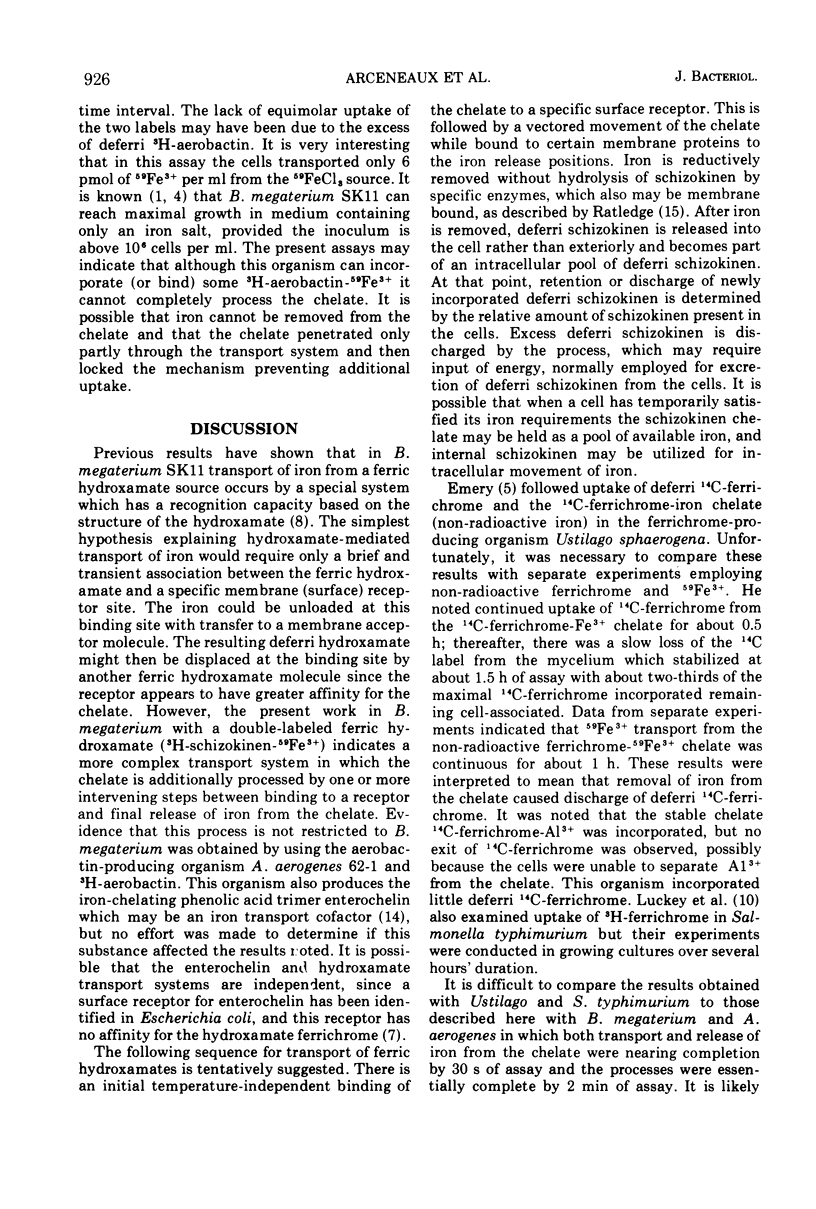Abstract
The fate of the hydroxamic acid-iron transport cofactors during iron uptake from the 59Fe3+ chelates of the 3H-labeled hydroxamates schizokinen and aerobactin was studied by assay of simultaneous incorporation of both 59Fe3+ and 3H. In the schizokinen-producing organism Bacillus megaterium ATCC 19213 transport of 59Fe3+ from the 3H-schizokinen-59Fe3+ chelate at 37 C was accompanied by rapid uptake and release (within 2 min) of 3H-schizokinen, although 3H-schizokinen discharge was temperature-dependent and did not occur at 0 C. In the schizokinen-requiring strain B. megaterium SK11 similar release of 3H-schizokinen occurred only at elevated concentrations of the double-labeled chelate; at lower chelate concentrations, 3H-schizokinen remained cell-associated. Temperature-dependent uptake of deferri (iron-free) 3H-schizokinen to levels equivalent to those incorporated from the chelate form was noted in strain SK11, but strain ATCC 19213 showed only temperature-independent binding of low concentrations of deferri 3H-schizokinen. These results indicate an initial temperature-independent binding of the ferric hydroxamate which is followed rapidly by temperature-dependent transport of the chelate into the cell and an enzyme catalyzed separation of iron from the chelate. The resulting deferri hydroxamate is discharged from the cell only when a characteristic intracellular concentration of the hydroxamate is exceeded, which happens in the schizokinen-requiring strain only at elevated concentrations of the chelate. This strain also appears to draw the deferri hydroxamate into the cell by a temperature-dependent mechanism. The aerobactin-producing organism Aerobacter aerogenes 62-1 also demonstrated rapid initial uptake and temperature-dependent discharge of 3H-aerobactin during iron transport from 3H-aerobactin-59Fe3+, suggesting a similar ferric hydroxamate transport system in this organism.
Full text
PDF








Selected References
These references are in PubMed. This may not be the complete list of references from this article.
- Arceneaux J. L., Lankford C. E. A schizokinen (siderochrome) auxotroph of Bacillus megaterium induced with N-methyl-N'-nitro-N-nitrosoguanidine. Biochem Biophys Res Commun. 1966 Aug 12;24(3):370–375. doi: 10.1016/0006-291x(66)90166-5. [DOI] [PubMed] [Google Scholar]
- Byers B. R., Powell M. V., Lankford C. E. Iron-chelating hydroxamic acid (schizokinen) active in initiation of cell division in Bacillus megaterium. J Bacteriol. 1967 Jan;93(1):286–294. doi: 10.1128/jb.93.1.286-294.1967. [DOI] [PMC free article] [PubMed] [Google Scholar]
- Davis W. B., Byers B. R. Active transport of iron in Bacillus megaterium: role of secondary hydroxamic acids. J Bacteriol. 1971 Aug;107(2):491–498. doi: 10.1128/jb.107.2.491-498.1971. [DOI] [PMC free article] [PubMed] [Google Scholar]
- Davis W. B., McCauley M. J., Byers B. R. Iron requirements and aluminum sensitivity of an hydroxamic acid-requiring strain of Bacillus megaterium. J Bacteriol. 1971 Feb;105(2):589–594. doi: 10.1128/jb.105.2.589-594.1971. [DOI] [PMC free article] [PubMed] [Google Scholar]
- Emery T. Role of ferrichrome as a ferric ionophore in Ustilago sphaerogena. Biochemistry. 1971 Apr 13;10(8):1483–1488. doi: 10.1021/bi00784a033. [DOI] [PubMed] [Google Scholar]
- Gibson F., Magrath D. I. The isolation and characterization of a hydroxamic acid (aerobactin) formed by Aerobacter aerogenes 62-I. Biochim Biophys Acta. 1969 Nov 18;192(2):175–184. doi: 10.1016/0304-4165(69)90353-5. [DOI] [PubMed] [Google Scholar]
- Guterman S. K. Inhibition of colicin B by enterochelin. Biochem Biophys Res Commun. 1971 Sep;44(5):1149–1155. doi: 10.1016/s0006-291x(71)80206-1. [DOI] [PubMed] [Google Scholar]
- Haydon A. H., Davis W. B., Arceneaux J. E., Byers B. R. Hydroxamate recognition during iron transport from hydroxamate-ion chelates. J Bacteriol. 1973 Sep;115(3):912–918. doi: 10.1128/jb.115.3.912-918.1973. [DOI] [PMC free article] [PubMed] [Google Scholar]
- Luckey M., Pollack J. R., Wayne R., Ames B. N., Neilands J. B. Iron uptake in Salmonella typhimurium: utilization of exogenous siderochromes as iron carriers. J Bacteriol. 1972 Sep;111(3):731–738. doi: 10.1128/jb.111.3.731-738.1972. [DOI] [PMC free article] [PubMed] [Google Scholar]
- MONOD J., COHEN-BAZIRE G., COHN M. Sur la biosynthèse de la beta-galactosidase (lactase) chez Escherichia coli; la spécificité de l'induction. Biochim Biophys Acta. 1951 Nov;7(4):585–599. doi: 10.1016/0006-3002(51)90072-8. [DOI] [PubMed] [Google Scholar]
- Mullis K. B., Pollack J. R., Neilands J. B. Structure of schizokinen, an iron-transport compound from Bacillus megaterium. Biochemistry. 1971 Dec 21;10(26):4894–4898. doi: 10.1021/bi00802a010. [DOI] [PubMed] [Google Scholar]
- Neilands J. B. Hydroxamic acids in nature. Science. 1967 Jun 16;156(3781):1443–1447. doi: 10.1126/science.156.3781.1443. [DOI] [PubMed] [Google Scholar]
- O'Brien I. G., Cox G. B., Gibson F. Enterochelin hydrolysis and iron metabolism in Escherichia coli. Biochim Biophys Acta. 1971 Jun 22;237(3):537–549. doi: 10.1016/0304-4165(71)90274-1. [DOI] [PubMed] [Google Scholar]
- Ratledge C. Transport of iron by mycobactin in Mycobacterium smegmatis. Biochem Biophys Res Commun. 1971 Nov;45(4):856–862. doi: 10.1016/0006-291x(71)90417-7. [DOI] [PubMed] [Google Scholar]
- Snow G. A. Mycobactins: iron-chelating growth factors from mycobacteria. Bacteriol Rev. 1970 Jun;34(2):99–125. doi: 10.1128/br.34.2.99-125.1970. [DOI] [PMC free article] [PubMed] [Google Scholar]


